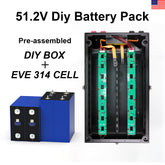Cómo elegir entre baterías del grupo 58 y del grupo 59
Al buscar una batería para auto, es fundamental elegir el tamaño y tipo adecuados. La batería es el corazón del sistema eléctrico de su auto, ya que alimenta todo, desde el motor hasta las luces e incluso el aire acondicionado. Algunos de los tamaños de batería más comunes son las del Grupo 58 y el Grupo 59. Comprender las diferencias entre estos dos tipos puede marcar una diferencia significativa en el rendimiento y la vida útil de su vehículo.
- Elija el tamaño de la batería: Grupo 58 vs. Grupo 59
- Elija el rendimiento de la batería: amperaje de arranque y capacidad de reserva
- Elija la compatibilidad de la batería: tipo de vehículo y demandas eléctricas
- Elija la durabilidad de la batería: vida útil y confiabilidad
- Elija Mantenimiento de la batería: Cuidado y carga
- Elija el precio de la batería: relación calidad-precio
En este artículo, analizaremos a fondo las baterías del Grupo 58 y del Grupo 59, abarcando aspectos como el tamaño, la potencia, la compatibilidad y más, para ayudarte a tomar la mejor decisión al elegir la batería para tu coche. Al finalizar esta guía, tendrás todo el conocimiento necesario para tomar una decisión informada. Analicemos en detalle estas dos populares opciones de batería.
>>Ver también ¿Los carros de golf tienen VIN o solo números de serie?
Elija el tamaño de la batería: Grupo 58 vs. Grupo 59
Elegir el tamaño correcto de batería es crucial para garantizar un rendimiento óptimo. El tamaño y la forma de la batería influyen en su capacidad para encajar en el compartimento de la batería del coche, así como en la eficiencia con la que alimenta el sistema eléctrico del vehículo. Las baterías del Grupo 58 y del Grupo 59 están diseñadas para diferentes tipos de vehículos y ofrecen distintas ventajas según sus necesidades.
Descripción general de la batería del grupo 58
Una batería del Grupo 58 se utiliza generalmente en vehículos con motores más pequeños, como autos compactos, autos medianos y algunas camionetas ligeras. Es conocida por su confiabilidad y alto amperaje de arranque (CA), esencial para arrancar el motor en climas fríos. Las baterías del Grupo 58 son ideales para conductores que necesitan una batería confiable y compacta que quepa en compartimentos más pequeños.
Descripción general de la batería del grupo 59
Por otro lado, las baterías del Grupo 59 son ligeramente más grandes y se utilizan comúnmente en vehículos con motores más grandes, como camionetas, SUV y autos de alto rendimiento. Estas baterías suelen ofrecer una mayor capacidad, lo que significa que pueden soportar una carga eléctrica más extensa y ofrecer un mejor rendimiento para vehículos con requisitos de potencia adicionales, como aquellos con sistemas de infoentretenimiento avanzados o iluminación adicional. Las baterías del Grupo 59 generalmente tienen mayor amperaje de arranque que las del Grupo 58, lo que las convierte en una opción ideal para vehículos de alta demanda.
Elija el rendimiento de la batería: amperaje de arranque y capacidad de reserva
Al elegir la batería de su vehículo, es fundamental comprender las clasificaciones de rendimiento. El amperaje de arranque (CA) y la capacidad de reserva (RC) son dos indicadores cruciales que debe evaluar. Tanto las baterías del Grupo 58 como las del Grupo 59 tienen diferentes amperajes de arranque y capacidad de reserva, lo que puede afectar la potencia de arranque y la autonomía de su vehículo.
Amperios de arranque (CA)
El amperaje de arranque mide la capacidad de una batería para arrancar un motor en climas fríos. En general, cuanto mayor sea el amperaje de arranque, mejor será el rendimiento de la batería a bajas temperaturas. Las baterías del Grupo 58 suelen ofrecer entre 500 y 650 amperios de arranque (CA), suficiente para la mayoría de los vehículos pequeños y medianos. Por otro lado, las baterías del Grupo 59 suelen ofrecer amperajes de arranque más altos, entre 600 y 750 CA, lo que las hace más adecuadas para vehículos más grandes que requieren más potencia para arrancar en climas fríos.
Capacidad de reserva (RC)
La capacidad de reserva indica la duración de la batería para los componentes eléctricos del vehículo, como las luces y la radio, en caso de fallo del alternador. Las baterías del grupo 58 suelen ofrecer una capacidad de reserva de unos 90 minutos, mientras que las del grupo 59 pueden ofrecer hasta 120 minutos o más. Esto las convierte en una mejor opción para vehículos con mayor demanda eléctrica o que operan en entornos donde la batería puede estar sometida a una carga prolongada.
Elija la compatibilidad de la batería: tipo de vehículo y demandas eléctricas
La compatibilidad de una batería con su vehículo es fundamental para determinar su rendimiento. Al elegir una batería, es importante considerar tanto el tamaño físico como las necesidades eléctricas de su vehículo.
Compatibilidad de baterías del grupo 58
Las baterías del Grupo 58 son ideales para autos compactos, medianos y camionetas pequeñas. Si su vehículo no requiere altas cargas eléctricas, como iluminación estándar y sistemas básicos de infoentretenimiento, una batería del Grupo 58 debería ser más que suficiente. Estas baterías se usan comúnmente en vehículos que no cuentan con electrónica avanzada ni funciones adicionales que consuman mucha energía. Además, suelen ser más ligeras y compactas, lo que las hace ideales para compartimentos de motor más pequeños.
Compatibilidad de baterías del grupo 59
Las baterías del Grupo 59 son más grandes y ofrecen mayor potencia, lo que las hace más compatibles con vehículos que requieren una mayor carga eléctrica. Las camionetas, SUV y vehículos de tamaño completo con motores más grandes o más accesorios eléctricos se beneficiarán del mayor rendimiento de una batería del Grupo 59. Por ejemplo, si su vehículo cuenta con un sistema de audio de alta gama, navegación avanzada o iluminación adicional, podría necesitar la potencia adicional que proporciona una batería del Grupo 59.
Elija la durabilidad de la batería: vida útil y confiabilidad
La vida útil de su batería es otro factor crucial al tomar su decisión. Necesita una batería que no solo satisfaga sus necesidades inmediatas, sino que también le brinde un servicio confiable durante un período prolongado. Tanto las baterías del Grupo 58 como las del Grupo 59 vienen en una variedad de opciones de calidad, pero generalmente, las baterías más grandes tienden a ofrecer una vida útil más larga debido a su mayor capacidad.
Durabilidad de la batería del grupo 58
Las baterías del Grupo 58 suelen durar entre 3 y 5 años, dependiendo del uso y las condiciones ambientales. Para conductores en climas templados que usan sus vehículos con poca frecuencia o para viajes cortos, una batería del Grupo 58 puede ofrecer un rendimiento estable durante varios años. Sin embargo, si vive en una región con temperaturas extremas o tiene un vehículo con un alto consumo eléctrico, la vida útil puede ser menor.
Durabilidad de la batería del grupo 59
Las baterías del Grupo 59 suelen tener una vida útil más larga, con un promedio de 4 a 6 años en condiciones óptimas. Estas baterías son más adecuadas para vehículos sometidos a un uso frecuente o intensivo, como camiones utilizados para remolcar o para uso todoterreno. Además, gracias a su mayor tamaño y capacidad, las baterías del Grupo 59 pueden soportar la tensión de varios sistemas eléctricos funcionando simultáneamente sin comprometer su longevidad.
Elija Mantenimiento de la batería: Cuidado y carga
El mantenimiento adecuado es esencial para prolongar la vida útil de cualquier batería, ya sea del Grupo 58 o del Grupo 59. Los controles y cuidados de rutina pueden garantizar que su batería siga funcionando de manera óptima y que no falle cuando más la necesite.
Grupo 58 Mantenimiento de la batería
Las baterías del Grupo 58 requieren poco mantenimiento, ya que solo requieren inspecciones periódicas para garantizar que estén libres de corrosión y firmemente conectadas. Si su vehículo cuenta con un sistema eléctrico relativamente sencillo, la batería del Grupo 58 debería requerir mínima atención. Asegúrese de revisar los terminales de la batería para detectar cualquier acumulación de corrosión, ya que esto puede afectar su rendimiento. Limpiar los terminales regularmente y revisar el nivel de líquido de la batería (si corresponde) garantizará una mayor vida útil.
Grupo 59 Mantenimiento de la batería
Si bien las baterías del Grupo 59 también requieren un mantenimiento básico, podrían requerir un cuidado adicional si alimentan sistemas eléctricos más complejos. Es fundamental revisar el nivel de carga de la batería y mantenerla limpia de suciedad y corrosión. En climas fríos, es especialmente importante asegurarse de que la batería esté correctamente cargada para evitar dificultades al arrancar el vehículo en los meses de invierno. Cuantos más sistemas eléctricos tenga su vehículo, más importante será supervisar el rendimiento de la batería.
Elija el precio de la batería: relación calidad-precio
Al elegir la batería de su vehículo, el precio suele ser un factor importante. Las baterías del Grupo 58 suelen ser más económicas que las del Grupo 59 debido a su menor tamaño y capacidad de potencia. Sin embargo, esto no significa que las baterías del Grupo 58 sean de menor calidad; siguen ofreciendo una excelente relación calidad-precio para vehículos más pequeños que no requieren tanta potencia.
Las baterías del Grupo 59 suelen ser más caras debido a su mayor tamaño, mayor amperaje de arranque y mejor rendimiento general. Si su vehículo requiere potencia adicional y necesita una batería que pueda soportar una mayor demanda eléctrica, la inversión en una batería del Grupo 59 puede valer la pena. La diferencia de precio entre estos dos tipos de baterías suele ser modesta, pero puede variar según la marca y las características específicas que necesite.
>>Vea también ¿Cuánto dura una batería de litio de 24 voltios?
Elija la batería que satisfaga sus necesidades
Elegir entre baterías del Grupo 58 y del Grupo 59 se reduce a comprender las necesidades de su vehículo y la potencia eléctrica que requiere. Si conduce un auto compacto o un vehículo más pequeño con un consumo de energía mínimo, una batería del Grupo 58 debería ser suficiente. Sin embargo, si tiene un vehículo más grande, como una SUV, una camioneta o un auto deportivo con sistemas eléctricos avanzados, la batería del Grupo 59 es la mejor opción.
En definitiva, al elegir una batería, debe asegurarse de que ofrezca el equilibrio adecuado entre potencia, durabilidad y precio para sus necesidades específicas. Considere sus hábitos de conducción, el clima donde vive y las necesidades eléctricas de su vehículo antes de tomar una decisión.
En resumen, ya sea que elija el Grupo 58 o el Grupo 59, ambas opciones ofrecen un rendimiento excelente para el vehículo adecuado. Al tener en cuenta los requisitos de su vehículo, se asegurará de que su nueva batería le brinde un buen servicio durante años. Elija la batería con cuidado y nunca tendrá que preocuparse por quedarse sin batería debido a una falla.
























Leave a comment
All blog comments are checked prior to publishing